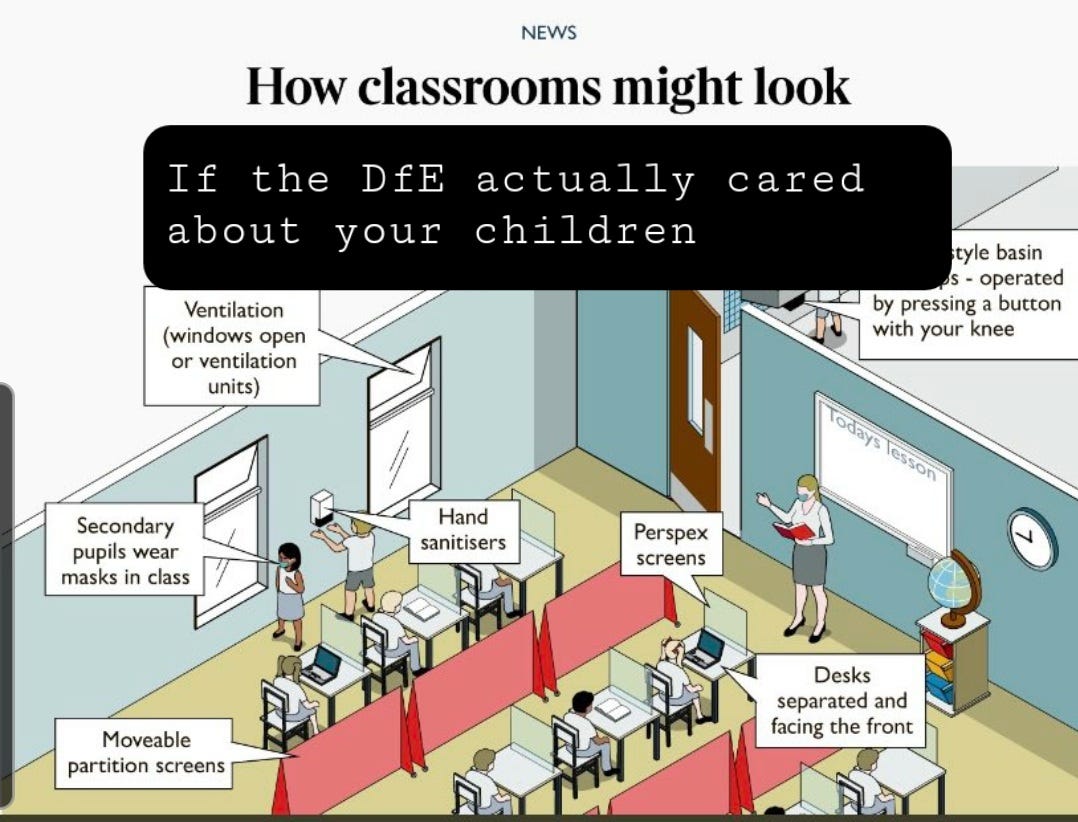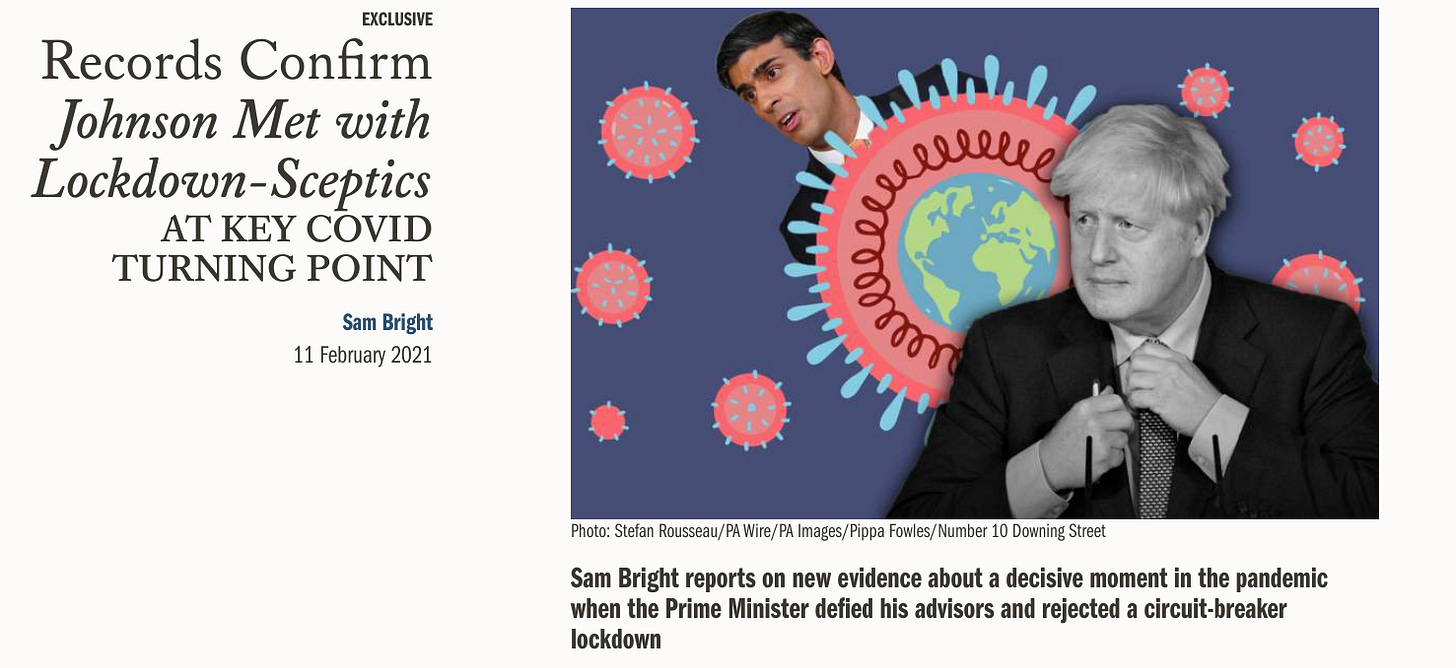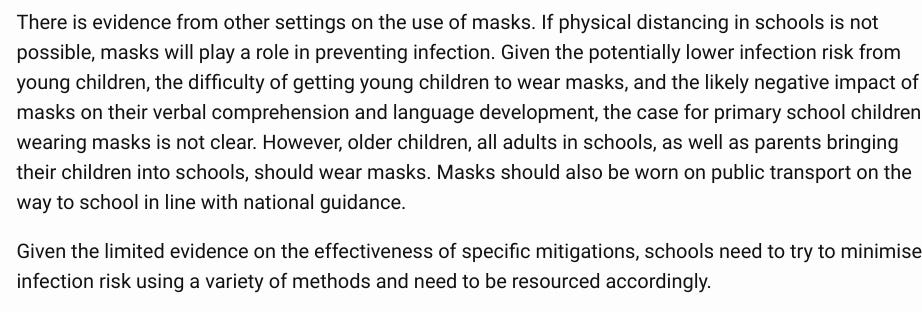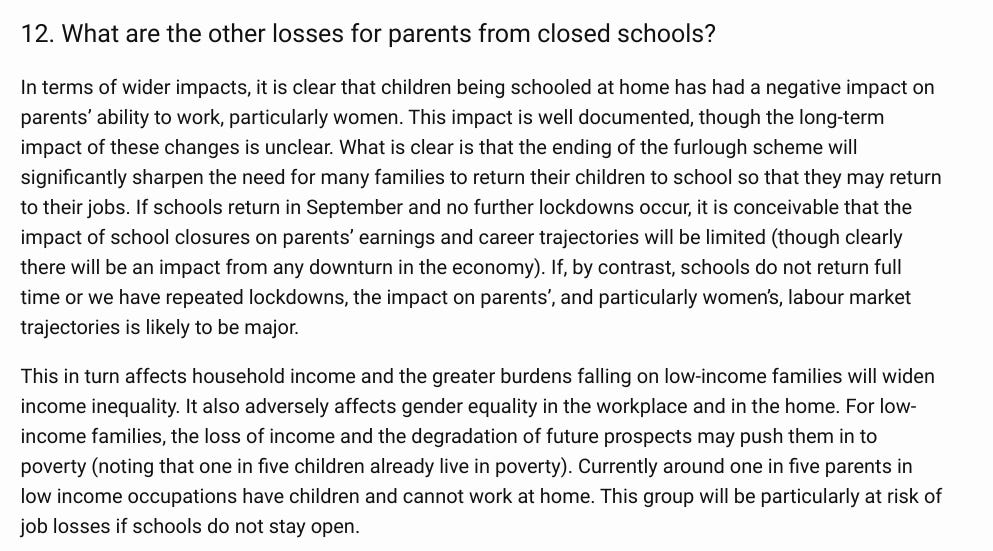7. Why did the UK ignore calls for a September circuit breaker?
And why was SAGE's advice to include schools ignored in November?
All students returned to school in September to full classrooms after millions were spent on a media campaign reassuring parents that schools were safe. Although this review focuses on the evidence base the government cited it’s worth noting how misleading the media campaign was. A number of media personalities and influencers telling parents about the “hierarchy of controls” that would be in place in September failed to mention they were part of a paid campaign. There was a promotional video showed students social distancing in almost empty corridors whilst wearing masks when in reality the DfE had said they would intervene against any school that tried to implement mask wearing.
A number of government advisers including Russell Viner did regular interviews repeating the phrase “schools have improved ventilation” when this only consisted of schools being told to open windows, where possible.
The picture below was published in a national newspaper, the comment about the DfE was added by a teacher, no state school classrooms looked like this in September. Hand sanitisers were installed but students sitting separately with screens was impossible to implement. Having researched into airborne transmission union Health and Safety reps understood that perspex screens were simply hygiene theatre.
A Daily Mail article from 24 August provides an example of the public health messaging at the time.
Deputy Chief Medical Officer Jenny Harries developed a track record for making statements that were consistently inaccurate, her claim children are more likely to be hit by a bus than catch covid was already demonstrably wrong.
One point from the Daily Mail article which stands out is the threat by the schools minister Nick Gibb that parents would be taken to court and fined if they didn’t trust the government’s promises that schools would be safe. When students returned in June many parents had refused to send their children to school demonstrating a lack of confidence, the government was worried that a repeat of this could lead to other parents changing their minds and so the DfE decided to force compliance in order to claim the return was a success.
Test and Trace has been identified by SAGE as a key measure for students to return, the system plagued with poor management was not in a fit state in September, to counter this the government promised schools would start the new year with a small supply of home PCR tests that could be sent off for processing. The majority of schools did not receive these.
Cases were starting to rise around the country after a couple of weeks into the start of term. In some regions such as the North East cases had not come down to low levels during the summer, which meant schools in these areas were already facing large scale disruption and staff shortages.
After spending several months telling the public schools would not contribute to increased transmission Deputy Prime Minister Dominic Raab was in the US when he was questioned about rising cases in the UK and the WHO’s concerns for the situation in Europe. Raab told CNN the government had expected cases to rise once schools returned but this wasn’t something to be concerned about. His comments were not picked up by the UK press as ministers continued to claim schools were safe and wouldn’t contribute to rising cases.
Link to his interview below.
September circuit breaker meeting
SAGE recommended a circuit breaker in September 2020 to reverse exponential growth.
FOI requests by the Byline Times revealed there were extensive meetings between Johnson and RW media outlets in the midst of calls for a circuit breaker.
A selection of headlines from September shows how sections of the media were lobbying hard in public against the introduction of measures.
16 September – Rule of six is damaging: Welby tells Johnson – Daily Telegraph
17 September – New clampdown to defeat virus would be ‘disastrous’ for the economy, Boris: I’ll Stop At Nothing To Avoid Second Lockdown – Daily Express
18 September – As PM warns “2nd wave is coming”, Rishi’s Pleas To Boris: Don’t Go Too Far – Daily Mail
22 September – UK Slammed into Reverse, Boris to impose new diktats amid fears of soaring infections - as row breaks out over doom-laden expert projections – Daily Express
24 September – Price We Can’t Afford To Pay – Daily Mail
25 September – Rishi: Now It’s Time To Live WIthout Fear, As he unveils plan to save jobs, Chancellor upstages cautious PM with new battle cry - and says what so many have been thinking – Daily Mail
26 September – Ministers’ plan to save Christmas at all costs, mass testing, roll out of vaccine and break from ‘rule of six’ all under consideration – Daily Telegraph
An FOI by the Byline Times obtained Boris Johnson’s meetings with journalists from July to September 2020 suggesting the same sections of the media were also lobbying Johnson directly against measures.
2 July – Gary Jones and Mick Booker, the Express and the Sunday Express
7 July – Tony Gallagher, the Times
9 July – Geordie Greig, Daily Mail
13 July – Victoria Newton, the Sun
22 July – Charles Moore, the Telegraph
18 September – Rupert Murdoch, News Corp
18 September – Rebekah Brooks, News Corp
21 September – Aidan and Howard Barclay, the Telegraph
21 September – Lord Rothermere, Daily Mail
21 September – Victoria Newton, the Sun
21 September – Geordie Grieg, Daily Mail
21 September – Tony Gallagher, the Times
21 September – Chris Evans, the Telegraph
21 September – Tim Davie and Fran Unsworth, senior BBC executives,
23 September – Fraser Nelson, the Spectator
The decisive point was said to be a meeting that Sunak arranged with Sunetra Gupta, Carl Heneghan and Anders Tegnell of Sweden. Henghan has written repeatedly for the Spectator so its odd that Nelson also forgot to mention this meeting.
What was discussed at this time appears to be a matter of debate, with Dominic Cummings’ account at odds with Sunak’s.
After Dominic Cummings’ departure from Downing Street he agreed to give evidence to parliament, the session went on for hours, with Cummings portraying himself as the voice of reason in a chaotic government. He was asked about the meeting on 20 September with Gupta, Heneghan and Tegnell.
‘Then, on the Sunday evening, there was a meeting with a combination of SAGE scientists and some external people.’ Dominic Cummings evidence further cited for the record ourselves
‘By this point, unfortunately, the Prime Minister was listening to various people who were saying things like, “There’s already herd immunity in the population; there won’t be any second wave, etc, etc.”
So we had the meeting in the Cabinet Room on Sunday evening. Patrick and Chris gave their view. A guy called Heneghan and a woman from Oxford called Professor Gupta, I think it was, gave the kind of ”Don’t lock down” view.
John Edmunds, who is on SAGE, said, “Surely we are going to learn the lessons of March. Here’s what the data will be. The only logic of not doing a lockdown now would be that you are not going to do it at all. There is no way that you are going to make that decision. Just do it now; otherwise it’s all going to be worse.”
The Prime Minister said, “I’m not persuaded of that.”
Although there is no official documentation from the meeting (according to FOI requests), Gupta and Heneghan produced written responses to Cumming’s comments. It was a call for “focused protection”.
Some interesting points from their evidence.
Gupta: The key issue to consider in directing policy is whether or not it is justified to take extraordinary measures in response to Covid-19 – given that no extraordinary measures are in place for other infectious diseases such as influenza, pneumococcal pneumonia, and indeed other coronaviruses. We have reached an accommodation with these other diseases and accept that they cause a level of disease, suffering and death, but not sufficient to change our way of life. Given that it is not possible or realistic to attempt to eliminate Covid-19, our goal should be to achieve levels of herd immunity that permit the same situation to prevail with Covid-19.
Heneghan: Xmas break - 5000 more deaths a week will occur at the height of the seasonal effect. Xmas can be extended for schools by 2 weeks with minimal disruption because of planning lead-in time. Could act as a breakwater at the height of viral respiratory illness “season”.
They suggested 5000 deaths a week was an acceptable death toll for keeping the economy open. Heneghan admits here that schools do have a significant impact on transmission suggesting schools shouldn’t return at the start of January. This evidence was submitted mid 2021Viner’s article in Science.org
21 September was a critical date for the trajectory of the UK’s second wave which proved to be the deadliest. SAGE had warned about rising cases and had recommended a short two week lockdown circuit breaker to bring cases down to low levels. A pre-cursor letter to the Great Barrington Declaration was released on the 21 September, a day after the government meeting with Gupta, Heneghan and Tegnell.
When a circuit breaker was finally declared in November schools weren’t included, the evidence base the government relied on for this policy decision deserves examining.
Russell Viner and Mathew Snape published an opinion piece which seemed to be aimed at reassuring the public.
For some reason the article was accompanied by a picture of primary school children wearing masks, this was a reoccurring theme across the media despite the fact no children were being asked to wear a mask. Even when mask wearing by secondary students was the topic of discussion pictures still featured younger students.
The piece begins by enthasising the low risk of children and suggests they don’t play a significant role in transmission. Long covid is described as being poorely understood and affecting a minority of children. The authors cite the harms of lockdown and call for access to services and education to be protected throughout subsequent waves.
The paper considers the evidence of contact tracing and prevalence studies, citing the following papers.
The severe post infection inflammatory condition Pims-TS and efforts to monitor and study cases is discussed. The paper then looks at potential treatments and mechanisms, a maladaptive acquired immune response is suggested
The authors then suggest the risks and benefits needed to be considered in regards to potential vaccines being trialled at the time. Children should be low priority unless vaccination would significantly reduce transmission.
The piece considers asymptomatic transmission concluding that there is likely little onward transmission. Asymptomatic transmission had already been well established by September 2020, the authors cite a lack of data due to school closures to suggest this might not be the case for children. The data cited will have been collected when student numbers were reduced so has limited use for predicting transmission when all students returned.
The impact on education is considered, with a quote from the DELVE report that a quarter of the entire workforce could have lower skills and attainment for a generation.
Studies are cited to show that lockdowns were more harmful that covid, however this was whilst infection rates in children were low. Even if the total number of accidents stayed the same, the proportion of them occurring in the home rather than other locations like schools will have increased. While the article suggests the suicide rate has increased, when reliable data was published it showed a decrease in suicide during lockdown,
The authors conclude education plays a limited role in transmission, future waves were inevitable and that there is plenty of evidence on the harms of mitigations. The paediatricians working with the government have consistently opposed mass testing and the use of masks or respirators.
The DELVE report
The Royal Society's DELVE report is cited multiple times in the article above. The evidence base the report relies on cites early work suggesting children were much less susceptible which will include Viner's April and May reviews, however it notes large scale European studies showed s smaller gap between adults and children particularly in Sweden.
This findings are weighed against UK studies like the ONS Infection Survey and reference to the “highest-quality studies” suggesting children are half as likely to be infected, this finding appears to come from Viner and Munro's review for RCPCH and Don't Forget the Bubbles.
The Delve report weights in favour of the UK produced evidence base finding the balance of evidence suggests children play a limited role in transmission.
The reasons for increased risk to BAME adults is considered to be fivefold, and BAME parents, careers and school staff were considered to be at increased risk. The DELVE report recommends they follow national guidance in respect of their particular risk factors, however the only guidance was for certain co-morbidities, shielding had been removed and the DfE guidance merely stated that those at risk should try and keep their distance and take precautions “where possible.” The only protection CEV workers or family members had in schools was what union reps were able to negotiate for them on a school by school basis.
BAME teachers weren’t considered to be at higher risk because they weren’t in a low income job, although this doesn’t take note of early career teachers living on their own or as single parents, particularly in high rental areas.
DELVE recommended masks for older students and recommended a variety of resourced measures, however there isn’t a focus on clean air.
Widely quoted figures on learning loss are in the DELVE report, there is an assumption whatever learning has been lost is unrecoverable and will impact a quarter of the workforce for fifty years. Poverty is linked to lower life expectancy.
This seems unlikely in the real world, considering the fluidity of the future jobs market it will be access to continual professional development and re-skilling that will determine lifetime earnings of our young people.
The report also considers the potential financial harm caused by not returning all students to school, this was due to the planned ending of furlough at the time (later extended). As with learning loss it suggests permanent harm to career trajectories could be caused by more lockdowns.
DELVE was published shortly after the government’s September plans were released, the report supports plans including the decision to make school compulsory. The compulsary element led to clinically vulnerable parents being fined and taken to court for withdrawing their children from school due to the number of infections occurring. The DfE guidance is said to provide “a lot of specific information for schools” without noting how much of the guidance on protective measures wasn’t compulsory, instead recommending “where possible”.
DELVE does recommend funding and resources for school to implement measures, this was promised by government, however the DfE didn’t’ fully reimburse school budgets additional expenditure. DELVE makes some solid broad suggestions for long term initiatives to reduce harms caused by loss of learning, unfortunately after appointing an adviser on education recovery the government chose not to fund the plans and the adviser resigned.
Full DELVE report here
Summary
Scientific advice to have a range of measures in schools was largely ignored, many of the sources of advice focused more on droplets and formites than on airborne transmission. DfE guidance was heavily caveated making more measures optional where possible rather than compulsory. This included protections for those identified as being at higher risk. Parents were threatened with court action if they refused to send their children into school. Reporting of school measures gave an impression of caution which bore little resemblance to reality.
As cases began to rise across the country a number of papers and articles were published suggesting schools played an insignificant role in transmission. These findings relied heavily on a small number of mainly UK studies by mainly the same handful of researchers.
Near the end of September the government chose not to implement a circuit breaker, instead implementing a tier system, in the highest tier schools were still expected to stay fully open. This was backed by the governments advisers on covid in children. Heneghan told the government that a focused protection strategy would result in a peak of 5000 deaths a week, in reality even with more measures the peak was considerably higher.
When a circuit breaker was introduced in November schools weren’t included, this was against SAGE’s advice. The government’s paediatric advisers continued to oppose school closures in the run up to 4 January when even Heneghan had suggested the school holidays should be extended by two weeks. That a supporter of the Great Barrington Declaration and member of Collateral Global urged more caution than senior figures of the RCPCH responsible for the UKs evidence base on covid in children is a remarkable but ignored fact.

























